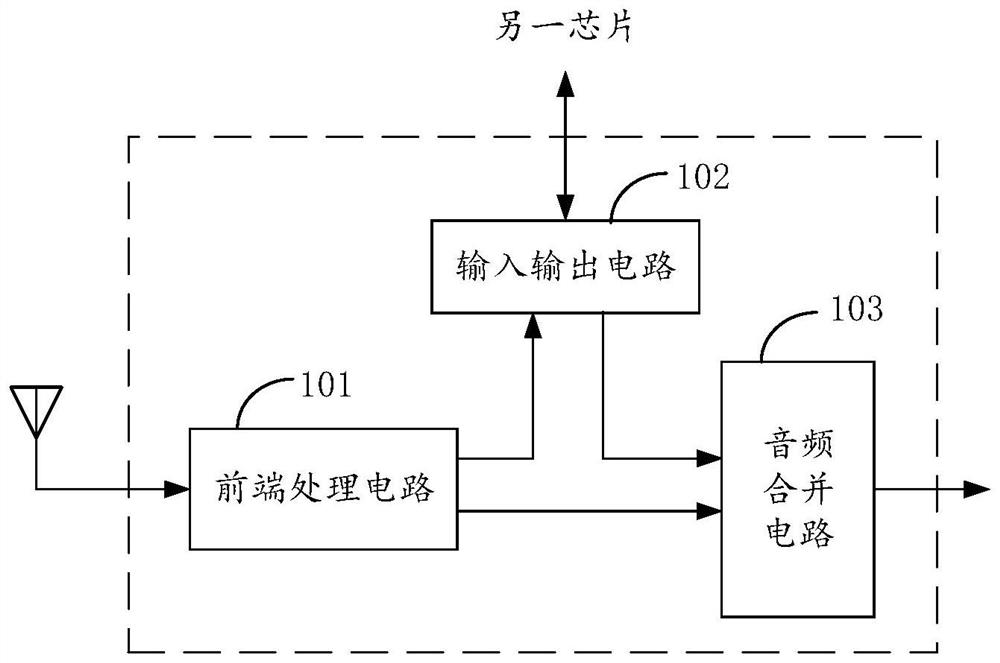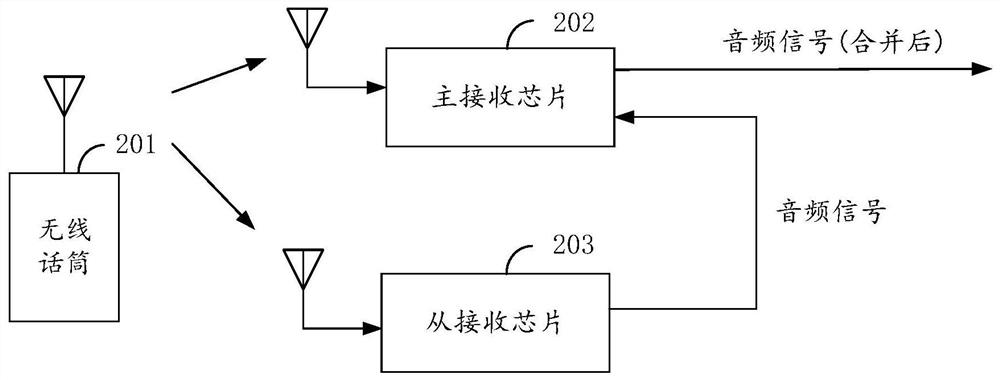An audio receiving chip and audio receiver
An audio receiving and receiver technology, applied in the direction of electrical components, signal processing, loudspeaker signal distribution, etc., can solve problems such as the complexity of the peripheral circuit of the chip, save implementation costs, reduce the degree of signal fading, and eliminate receiving dead zones Effect
- Summary
- Abstract
- Description
- Claims
- Application Information
AI Technical Summary
Problems solved by technology
Method used
Image
Examples
no. 1 example
[0042] This embodiment provides an audio receiving chip configured in an audio receiver, refer to figure 2 , the audio receiving chip comprises a front-end processing circuit 101, an input-output circuit 102 and an audio combining circuit 103, and the front-end processing circuit 101 is connected with the antenna of the audio receiver, the input-output circuit 102 and the audio combining circuit 103 respectively, and the input-output circuit 102 is connected to the audio frequency combining circuit 103. The combining circuit 103 is connected. The antenna is used to receive a radio frequency signal, and the front-end processing circuit 101 is used to demodulate the radio frequency signal received by the antenna to obtain a first audio signal carried in the radio frequency signal. The audio receiving chip can be configured in any one of the master mode and the slave mode. When configured in different modes, the input and output circuit 102 and the audio combining circuit 103 wo...
no. 2 example
[0076] This embodiment provides an audio receiving chip, refer to Figure 8 The audio receiving chip includes a front-end processing circuit 101, a framing circuit 104, and an input-output circuit 102. The front-end processing circuit 101 is connected to the antenna of the audio receiver and the framing circuit 104, and the framing circuit 104 is connected to the input-output circuit 102.
[0077] The difference between the audio receiving chip and the audio receiving chip provided by the first embodiment is that the circuit modules that are not used in the slave mode are removed. Therefore, the working principle and optional implementation of each circuit module in the audio receiving chip For the method, refer to the description of the previous embodiment.
[0078] Since the audio receiving chip reduces the number of circuit modules that are turned off in the slave mode, while simplifying the peripheral circuit of the chip, the circuit of the audio receiving chip itself is a...
no. 3 example
[0083] This embodiment provides an audio receiver, refer to Figure 10 , the audio receiver includes two antennas 301 ; two audio receiving chips 302 ; and an audio output interface 303 . Wherein, each audio receiving chip 302 is used to receive the radio frequency signal transmitted from the corresponding antenna 301, and demodulate the radio frequency signal to obtain the audio signal carried in the radio frequency signal, one of the audio receiving chips in the two audio receiving chips The obtained audio signal and the audio signal from another audio receiving chip are combined and output through the audio combining circuit.
[0084] Optionally, the audio signal output by the audio combining circuit can be a digital audio signal, and the output end of the audio combining circuit can be connected with a digital-to-analog converter, and the digital audio signal is converted into an analog audio signal by the digital-to-analog converter, And it can be output to the sound amp...
PUM
 Login to View More
Login to View More Abstract
Description
Claims
Application Information
 Login to View More
Login to View More - R&D
- Intellectual Property
- Life Sciences
- Materials
- Tech Scout
- Unparalleled Data Quality
- Higher Quality Content
- 60% Fewer Hallucinations
Browse by: Latest US Patents, China's latest patents, Technical Efficacy Thesaurus, Application Domain, Technology Topic, Popular Technical Reports.
© 2025 PatSnap. All rights reserved.Legal|Privacy policy|Modern Slavery Act Transparency Statement|Sitemap|About US| Contact US: help@patsnap.com



